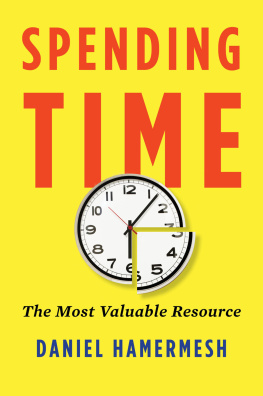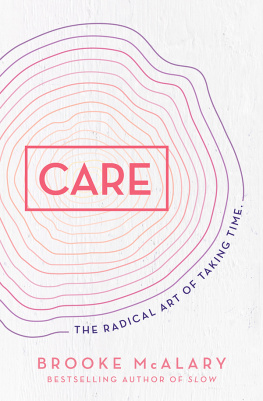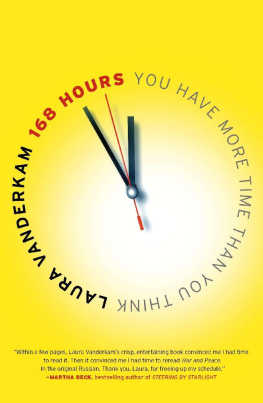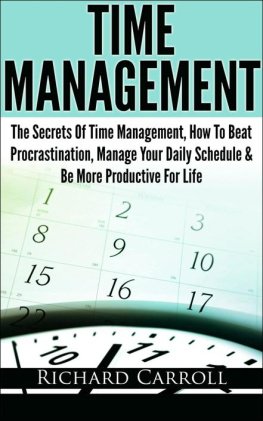Spending Time

Oxford University Press is a department of the University of Oxford. It furthers the Universitys objective of excellence in research, scholarship, and education by publishing worldwide. Oxford is a registered trade mark of Oxford University Press in the UK and certain other countries.
Published in the United States of America by Oxford University Press
198 Madison Avenue, New York, NY 10016, United States of America.
Oxford University Press 2019
All rights reserved. No part of this publication may be reproduced, stored in a retrieval system, or transmitted, in any form or by any means, without the prior permission in writing of Oxford University Press, or as expressly permitted by law, by license, or under terms agreed with the appropriate reproduction rights organization. Inquiries concerning reproduction outside the scope of the above should be sent to the Rights Department, Oxford University Press, at the address above.
You must not circulate this work in any other form and you must impose this same condition on any acquirer.
Library of Congress Cataloging-in-Publication Data
Names: Hamermesh, Daniel S., author.
Title: Spending time : the most valuable resource / Daniel S. Hamermesh.
Description: New York : Oxford University Press, [2018] |
Includes bibliographical references and index.
Identifiers: LCCN 2018027022 (print) | LCCN 2018028064 (ebook) |
ISBN 9780190853846 (UPDF) | ISBN 9780190853853 (EPUB) |
ISBN 9780190853839 (hardcover : alk. paper)
Subjects: LCSH: TimeSocial aspects. | Time management.
Classification: LCC HM656 (ebook) | LCC HM656 .H36 2018 (print) |
DDC 650.1/1dc23
LC record available at https://lccn.loc.gov/2018027022
Contents
Given all these efforts, why yet another book on time? The best answer is that how we use time and why we make choices about time should be fundamentally interesting questions for everyone. Time and money are the two scarcest things in everyones life, and in most countries incomes have grown greatly over the past fifty years. Time has not.
No book has discussed the panoply of ways that we use time and how those differ among countries, and none has tried to explain why people differ in their use of time.
The US now has what is in many ways the best information in the world about how its citizens spend their time. Before 2000, many other countries, and the US too, had very occasional surveys in which respondents kept diaries that were completed on the next day and recorded what they
When I began working on time use I remarked that the US was in the derrire garde in the creation of data that allow chronicling how people spend time. That is no longer true. In 2003, the American Time Use Survey (ATUS), a product of the US Bureau of Labor Statistics (BLS), began collecting time diaries each month that are completed by about a thousand randomly chosen Americans ages fifteen or over, in which they record their activities on the previous day. With this survey the US has created a continuing record of Americans spending their time. No other country has done this, so today the US is clearly in the avant garde in its provision of the information with which to analyze its citizens decisions about spending time. I use the ATUS for the years 20032015, about 170,000 diaries, throughout this study, so that original calculations based on the ATUS underlie many of the statistics presented, obviating the need in these cases to refer to the underlying set of data. I am extremely grateful to the Minnesota Population Center and the Maryland Population Research Center for producing the ATUS data sets based on the raw BLS data.
American scholars are remarkably ethnocentric in their concentration on domestic issues, in far too many cases basing general conclusions about peoples behavior solely on results produced using American data. And because of the predominance of American scholarship worldwide, especially in economics, scholarly research too often gives the impression that we have learned something about peoples behavior generally, when in fact we have only learned about the behavior of the less than 5 percent of the worlds population that resides in the US.
If Americans use of time were representative of time use worldwide, or at least of that in other rich countries, there would be no problem. As I show throughout the book, though, along some dimensions Americans use time much differently than do citizens of other wealthy countries. To demonstrate these differences, and to understand how people generally spend time, on most of the topics that I discuss I also present evidence based on time diaries kept by people elsewhere. While I use information from many countries, including Australia, Canada, Italy, Japan, Korea, the Netherlands, Portugal, and Spain, most of the comparative analysis relies on original calculations using time diaries collected in three large wealthy European countries: France (Enqute emploi du temps, 20092010, about 24,000 diaries); Germany (Zeitverwendungserhebung, 20122013, about 25,000 diaries), and the United Kingdom (Time Use Survey, 20142015, about 16,000 diaries). In some cases, I use these data instead of the American data because the latter lack information on some crucial aspects of time use. I thank the Centre Maurice Halbwachs in Paris, the Statistiches Bundesamt in Wiesbaden, and the Multinational Time Use Survey of Oxford University for providing these data sets. Here too, when I refer to calculations for each of these countries, I am referring to calculations based on these particular sets of data.
With much of the discussion based on previous analyses of data or on new analyses using these four sets of data, the question is how to present the results in an interesting and readable way. From my experience teaching more than 25,000 undergraduates over the past fifty years, Im convinced that figurespictureswork better than tables of numbers. For that reason, there are thirty figures in the text but no tables at all. There are also none of the equations that are so beloved by economists. The figures are completely self-explanatory, and the reader should be able to infer the message of each figure at a glance. Because of my technological incompetence, the figures were drawn by other people, with Yonah Meiselman offering tremendous help.
I began working on questions about peoples use of time in the late 1980s, publishing in 1990 two scholarly articles on the subject, both based on US time-diary information from the mid-1970s. Since then I have been continually studying questions related to time use, increasingly in conjunction with other economists. Many of the ideas in this book and much of the information presented come from these joint efforts. The volume would not have been possible without the ideas and labor that these scholars have supplied over the years. Thus Jeff Biddle, Hielke Buddelmeyer, Michael Burda, Ana Rute Cardoso, Katie Genadek, Reuben Gronau, Daiji Kawaguchi, Jungmin Lee, Caitlin Myers, Gerard Pfann, Mark Pocock, Joel Slemrod, Elena Stancanelli, Stephen Trejo, Jos Vareja, Philippe Weil, and Mark Wooden have all published scholarly work with me that provides the basis for some of the arguments here. While it wouldnt be fair to implicate any of them as coauthors, their work and inspiration clearly made this book possible.
Other people too can be thanked as unindicted co-conspirators. A Barnard student, Mia Lindheimer, made a useful suggestion; and our New York neighbor, Kevin Hyams, made a very helpful point. George Borjas offered help on organization. My sister, Deborah White, caught some errors in the final draft. My wife, Frances Witty Hamermesh, read every word in the first and second drafts and greatly improved the logic of the exposition and the arrangement of the ideas.











